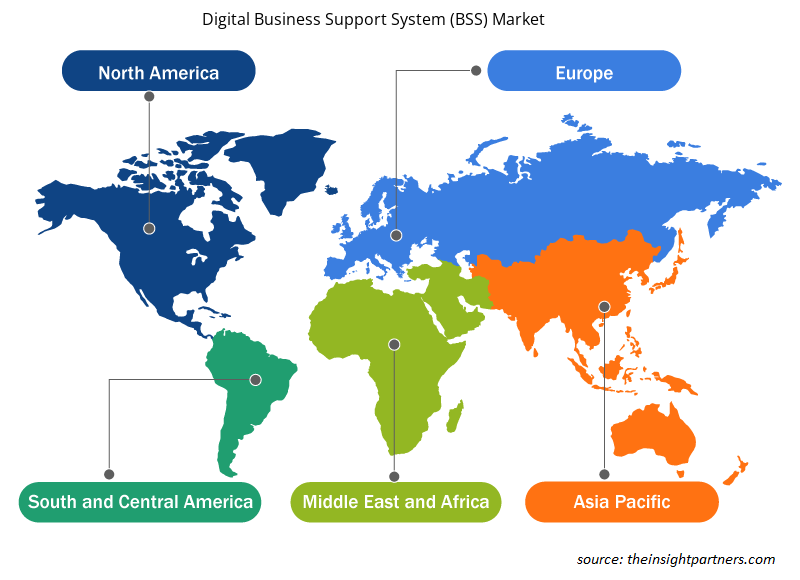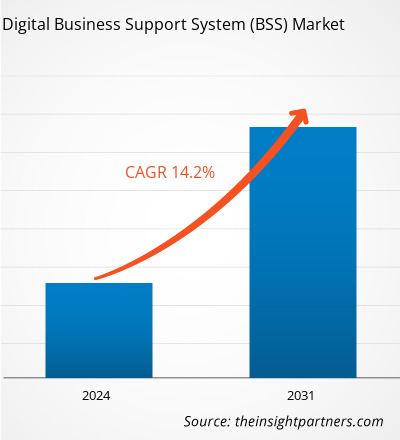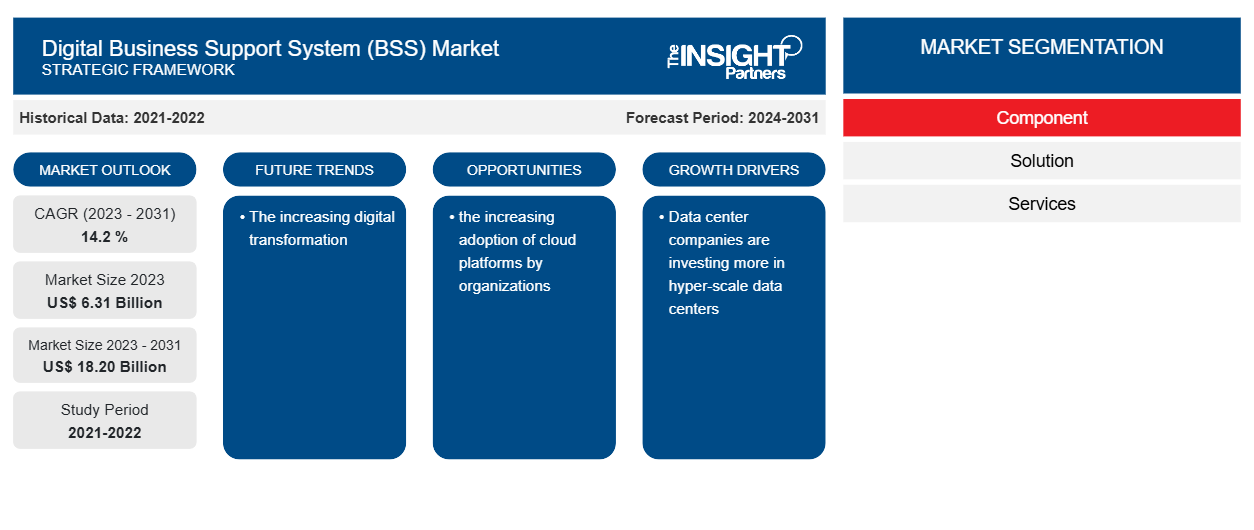Se proyecta que el tamaño del mercado del sistema de soporte empresarial digital (BSS) alcance los 18,20 mil millones de dólares estadounidenses para 2031, desde los 6,31 mil millones de dólares estadounidenses en 2023. Se espera que el mercado registre una CAGR del 14,2 % en 2023-2031.BSS) Market size is projected to reach US$ 18.20 billion by 2031 from US$ 6.31 billion in 2023. The market is expected to register a CAGR of 14.2 % in 2023–2031. ElEs probable que la creciente transformación digital siga siendo una tendencia clave del mercado de sistemas de soporte empresarial digital (BSS).BSS) Market trend.
Análisis del mercado de sistemas de soporte empresarial digital (BSS)
El mercado de sistemas de soporte empresarial digital está creciendo rápidamente debido a una serie de factores, entre ellos la creciente adopción de soluciones BSS personalizadas y nuevos modelos comerciales, el aumento de los costos operativos reducidos, el aumento de las transacciones en línea y el uso de múltiples dispositivos móviles, la creciente aceptación de soluciones BSS basadas en la nube, la creciente tendencia a la digitalización en la industria de las telecomunicaciones y la creciente adopción de sistemas de soporte empresarial digital por parte de los fabricantes con el fin de agregar valor al negocio maximizando el retorno de la inversión, proporcionando un servicio al cliente superior, reduciendo costos y acelerando el tiempo de comercialización de nuevos productos y servicios.
Descripción general del mercado de sistemas de soporte empresarial digital (BSS)
Un sistema de soporte comercial digital es un tipo de plataforma o solución que ofrece a las empresas comerciales ventajas operativas y de seguimiento. La recepción de pedidos, las consultas relacionadas con los pagos y la gestión de los ingresos de los clientes forman parte del sistema de soporte comercial. Además de ofrecer numerosas herramientas adicionales de gestión de operaciones, el sistema proporciona a las empresas información sobre el marketing y las operaciones de la empresa, lo que les permite tomar decisiones bien informadas sobre los lanzamientos de productos y los gastos de marketing .
Personalice este informe según sus necesidades
Obtendrá personalización en cualquier informe, sin cargo, incluidas partes de este informe o análisis a nivel de país, paquete de datos de Excel, así como también grandes ofertas y descuentos para empresas emergentes y universidades.
-
Obtenga las principales tendencias clave del mercado de este informe.Esta muestra GRATUITA incluirá análisis de datos, desde tendencias del mercado hasta estimaciones y pronósticos.
Impulsores y oportunidades del mercado de los sistemas de soporte empresarial digital (BSS)
Las empresas de centros de datos están invirtiendo más en centros de datos de hiperescala.
Numerosas empresas de centros de datos han realizado inversiones significativas en centros de datos de hiperescala, que se prevé que generen perspectivas de expansión rentables. Equinix reveló sus intenciones de construir alrededor de 32 centros de datos de hiperescala en algunos mercados europeos importantes el año pasado. Con una inversión de más de 6.900 millones de dólares y una capacidad total de más de 600 megavatios, la empresa espera mejorar su posición en el mercado de centros de datos de hiperescala, que está en rápido desarrollo. La demanda del mercado HCI en la región aumentará como resultado de esta expansión de los centros de datos en el área.Equinix revealed intentions to build about 32 hyper-scale data centers in a few significant European markets last year. Investing more than USD 6.9 billion and having a total capacity of over 600 megawatts, the company hopes to improve its standing in the rapidly developing hyper-scale data center market. The demand for the HCI market in the region will rise as a result of this expansion of the data centers in the area.
La creciente adopción de plataformas en la nube por parte de las organizaciones
Se prevé que la creciente adopción de plataformas en la nube por parte de las organizaciones, en particular en las naciones emergentes, impulse el crecimiento del mercado de sistemas de soporte empresarial digital en Asia-Pacífico. Por ejemplo, se espera que la adopción de cargas de trabajo en la nube híbrida en la India se triplique del 13 % al 43 %, según el Nutanix Cloud Index. La corporación se está centrando más en la expansión empresarial y el desarrollo de nuevos productos como resultado del mayor uso de tecnologías digitales para la interacción con los consumidores. Por lo tanto, se prevé que la creciente necesidad de precisión y gestión de datos presente nuevas oportunidades para los actores del mercado de sistemas de soporte empresarial digital (BSS) durante el período de pronóstico.Nutanix Cloud Index. The corporation is focusing more on business expansion and new product development as a result of the increased use of digital technologies for consumer engagement. Thus, the increasing need for data accuracy and data management is anticipated to present new opportunities for the Digital Business Support System (BSS) Market players during the forecast period.
Análisis de segmentación del informe de mercado de sistemas de soporte empresarial digital (BSS)BSS) Market Report Segmentation Analysis
Los segmentos clave que contribuyeron a la derivación del análisis del mercado del Sistema de soporte empresarial digital (BSS) son los componentes.BSS) Market analysis are components.
- Según el componente, el mercado de sistemas de soporte empresarial digital (BSS) se segmenta en soluciones y servicios. El segmento de servicios tuvo una mayor participación de mercado en 2023.BSS) Market is segmented into solutions and services. The services segment held a larger market share in 2023.
Análisis de la cuota de mercado de los sistemas de soporte empresarial digital (BSS) por geografíaBSS) Market Share Analysis by Geography
El alcance geográfico del informe de mercado de sistemas de soporte empresarial digital (BSS) se divide principalmente en cinco regiones: América del Norte, Asia Pacífico, Europa, Oriente Medio y África, y América del Sur/América del Sur y Central. En términos de ingresos, América del Norte representó la mayor participación de mercado de sistemas de soporte empresarial digital (BSS). En comparación con otras regiones, América del Norte está experimentando un crecimiento más rápido en la cultura de las empresas emergentes. El surgimiento de las pymes y la creciente digitalización de la industria de las telecomunicaciones han contribuido a la expansión del mercado de BSS digital en América del Norte. La creciente accesibilidad de las soluciones basadas en la nube es otro factor que impulsa la adopción de soluciones BSS digitales en la región. En comparación con las soluciones locales convencionales, las soluciones BSS basadas en la nube tienen una variedad de beneficios, como menores costos iniciales, mayor seguridad y escalabilidad flexible. Estos elementos probablemente contribuirán al crecimiento continuo de América del Norte en la adopción de soluciones BSS digitales en los próximos años.
Perspectivas regionales del mercado de sistemas de soporte empresarial digital (BSS)
Los analistas de Insight Partners explicaron en detalle las tendencias y los factores regionales que influyen en el mercado de sistemas de soporte empresarial digital (BSS) durante el período de pronóstico. Esta sección también analiza los segmentos y la geografía del mercado de sistemas de soporte empresarial digital (BSS) en América del Norte, Europa, Asia Pacífico, Oriente Medio y África, y América del Sur y Central.BSS) Market throughout the forecast period have been thoroughly explained by the analysts at Insight Partners. This section also discusses Digital Business Support System (BSS) Market segments and geography across North America, Europe, Asia Pacific, Middle East and Africa, and South and Central America.

- Obtenga datos regionales específicos para el mercado de sistemas de soporte empresarial digital (BSS)
Alcance del informe de mercado del sistema de soporte empresarial digital (BSS)
| Atributo del informe | Detalles |
|---|---|
| Tamaño del mercado en 2023 | 6.310 millones de dólares estadounidenses |
| Tamaño del mercado en 2031 | US$ 18,20 mil millones |
| CAGR global (2023 - 2031) | 14,2 % |
| Datos históricos | 2021-2022 |
| Período de pronóstico | 2024-2031 |
| Segmentos cubiertos |
Por componente
|
| Regiones y países cubiertos |
América del norte
|
| Líderes del mercado y perfiles de empresas clave |
|
Densidad de actores del mercado de sistemas de soporte empresarial digital (BSS): comprensión de su impacto en la dinámica empresarial
El mercado de sistemas de soporte empresarial digital (BSS) está creciendo rápidamente, impulsado por la creciente demanda de los usuarios finales debido a factores como la evolución de las preferencias de los consumidores, los avances tecnológicos y una mayor conciencia de los beneficios del producto. A medida que aumenta la demanda, las empresas amplían sus ofertas, innovan para satisfacer las necesidades de los consumidores y aprovechan las tendencias emergentes, lo que impulsa aún más el crecimiento del mercado.
La densidad de actores del mercado se refiere a la distribución de las empresas o firmas que operan dentro de un mercado o industria en particular. Indica cuántos competidores (actores del mercado) están presentes en un espacio de mercado determinado en relación con su tamaño o valor total de mercado.
Las principales empresas que operan en el mercado de sistemas de soporte empresarial digital (BSS) son:
- Amdocs Limitada
- Tecnologías Huawei Co., Ltd.
- Telefonaktiebolaget LM Ericsson
- Corporación de tecnología NetCracker
- Sistemas CSG Internacional, Inc.
- Optiva Inc.
Descargo de responsabilidad : Las empresas enumeradas anteriormente no están clasificadas en ningún orden particular.

- Obtenga una descripción general de los principales actores clave del mercado del sistema de soporte empresarial digital (BSS)
Noticias y desarrollos recientes del mercado de sistemas de soporte empresarial digital (BSS)
El mercado de sistemas de apoyo empresarial digital (BSS) se evalúa mediante la recopilación de datos cualitativos y cuantitativos posteriores a la investigación primaria y secundaria, que incluye publicaciones corporativas importantes, datos de asociaciones y bases de datos. A continuación, se incluye una lista de los avances en el mercado de los trastornos del habla y el lenguaje y las estrategias:
- En junio de 2023, IBM y Vista Equity Partners firmaron un acuerdo final para que IBM adquiera Apptio Inc. Las capacidades de automatización de TI de IBM crecerán más rápidamente como resultado de la adquisición de Apptio, lo que brindará a los ejecutivos de negocios la capacidad de maximizar el retorno de sus inversiones en TI.
(Fuente: IBM, Nota de prensa)
- En julio de 2022, Ericsson compró Vonage, avanzando en el plan de la compañía de utilizar su posición como líder en tecnología para impulsar su negocio de redes móviles y penetrar en la empresa.
(Fuente: Ericsson, Nota de prensa)
Informe de mercado sobre sistemas de soporte empresarial digital (BSS) y resultados finales
El informe “Tamaño y pronóstico del mercado del sistema de soporte empresarial digital (BSS) (2021-2031)” proporciona un análisis detallado del mercado que cubre las siguientes áreas:
- Tamaño del mercado y pronóstico a nivel global, regional y nacional para todos los segmentos clave del mercado cubiertos bajo el alcance
- Dinámica del mercado, como impulsores, restricciones y oportunidades clave
- Principales tendencias futuras
- Análisis detallado de las cinco fuerzas de Porter y PEST y FODA
- Análisis del mercado global y regional que cubre las tendencias clave del mercado, los principales actores, las regulaciones y los desarrollos recientes del mercado.
- Análisis del panorama de la industria y de la competencia que abarca la concentración del mercado, el análisis de mapas de calor, los actores destacados y los desarrollos recientes
- Perfiles detallados de empresas
- Análisis histórico (2 años), año base, pronóstico (7 años) con CAGR
- Análisis PEST y FODA
- Tamaño del mercado, valor/volumen: global, regional y nacional
- Industria y panorama competitivo
- Conjunto de datos de Excel
Informes recientes
Testimonios
Razón para comprar
- Toma de decisiones informada
- Comprensión de la dinámica del mercado
- Análisis competitivo
- Información sobre clientes
- Pronósticos del mercado
- Mitigación de riesgos
- Planificación estratégica
- Justificación de la inversión
- Identificación de mercados emergentes
- Mejora de las estrategias de marketing
- Impulso de la eficiencia operativa
- Alineación con las tendencias regulatorias























 Obtenga una muestra gratuita para - Mercado de sistemas de apoyo empresarial digital (BSS)
Obtenga una muestra gratuita para - Mercado de sistemas de apoyo empresarial digital (BSS)